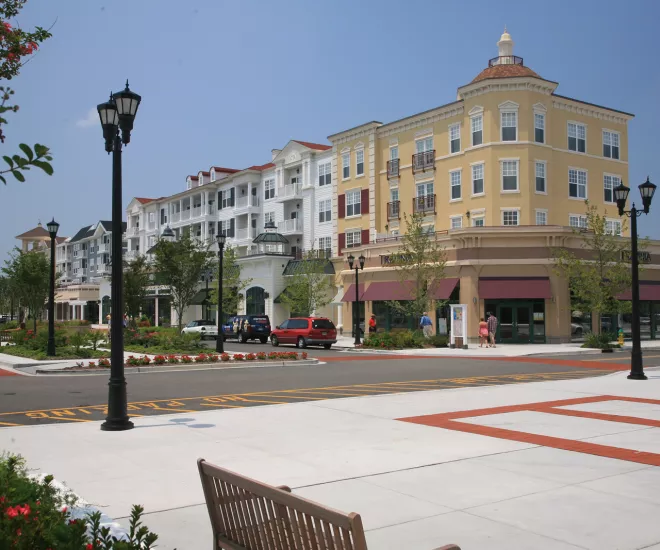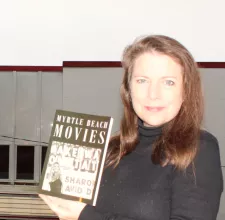Visit Doolittle Lake Honoring Famous WWII Heroes

When you enter Myrtle Beach’s Market Common District which is located just south of the airport, you do so by either Highway 17 Bypass or Highway 17 Business, better known as Kings Highway. Most likely when you do, you use Farrow Parkway that reaches end to end to both of these highways to make your way into the heart of the district where the streets are named for military heroes associated with the history of the Myrtle Beach Air Force Base which was located where the district is now from 1956 to 1993.
Even if you go a little south of Farrow Parkway and enter the district via Mallard Lake Drive from Kings Highway, you find yourself in a neighborhood that was once base housing and looks almost exactly as it did when it was built in the mid Twentieth Century. The streets there maintain their original names taken mostly from trees and other flora. The only names that needed to be changed there were ones that were identical to those already within the city limits of Myrtle Beach. This was done out of a safety concern so there would be no confusion when 911 dispatchers sent emergency personnel on a call.

However, if you enter the district a little south of Farrow Parkway from the Bypass on Coventry Boulevard, you see no military references at all in the street names. They all have British-inspired names. These current neighborhoods were almost entirely woodlands during the base’s time so the military references were not applied. Although there are two significant nods to specific men who carried out one of the highest profile secret missions early in WWII.
That mission was Jimmy Doolittle’s Tokyo Raiders’ bombing of Japan. It was the first US attack on Japanese soil after Pearl Harbor. They were the 80 men on 16 B-25s who bombed significant military targets in Japan on April 18th, 1942.
When you take Coventry Boulevard and have passed Berkshire Avenue on your right, look to the left and you will see signs for the entrance of Emmens Preserve. It is named for Colonel Robert Emmens who was the commander of the base during its construction from 1954 to 1956. He was also a Doolittle Raider.
Your next street to the right is Yorkshire Parkway. Turn there. Shortly on your right you will see a lake that is flanked by High Street and Paddington Street. That is Doolittle Lake. On-street parking on High Street is the most convenient for your visit. Walk toward a lovely little garden that is situated closest to the corner of Yorkshire Parkway and High Street. Embedded in the sidewalk, you will see a paver that reveals that you have arrived at the Doolittle Goblet Ceremony Victory Garden at Doolittle Lake. There is an image of two goblets. One is upright. The other is upside down.
To explain what this all means, there are three panels affixed to a low brick wall that tell the following story:
In December 1946, Gen. James “Jimmy” Doolittle and his fellow Raiders gathered to celebrate his birthday, and that event turned into an annual reunion. In 1959, The City of Tucson, Arizona, presented the Doolittle Raiders with this set of silver goblets, each bearing the name of one of the 80 men who flew on the mission.
At every reunion, the surviving Raiders meet privately to conduct a solemn “Goblet Ceremony.” After toasting the Raiders who died since their last meeting, they turn the deceased men’s goblets upside down. Each goblet has the Raider’s name engraved twice, so that it can be read if the goblet is right side up or upside down.
The president of the Hennessy Company gave Doolittle a bottle of Hennessy Very Special Cognac-Vintage 1896, the year of Doolittle’s birth. When there are only two Raiders left, these two men will open the bottle and once again toast their departed comrades.
-Michael Emmens, Son of Colonel Robert G. Emmens, May 4, 2009
Those goblets were faithfully used at each annual gathering. Between reunions they were put on display at the Air Force Academy at Colorado Springs, Colorado. Jimmy Doolittle himself handed them over to the superintendent of the Academy for safekeeping. That transfer took place during halftime at a U.S. Air Force Academy football game.
In 1973, Doolittle’s co-pilot during the famous raid, Richard E. “Dick” Cole, built a portable display case to transport the goblets from the Academy to wherever their reunion was being held that year and then safely returned to Colorado. In 2005, the goblets were moved to their new location at the National Museum of the United States Air Force. The remaining Raiders thought that it would be a good place for the goblets to have a permanent home.
Dedicated September 3, 1971, the National Museum of the U.S. Air Force is located near Dayton, Ohio, at Wright-Patterson Air Force Base. It is the world’s largest military aviation museum. Another museum in Dayton, the Wright Brothers National Museum, according to their website, “has more Wright artifacts on display than any other place in the world, including the 1905 Wright Flyer III: the only airplane designated a National Historic Landmark…”
Back at Wright-Patterson, the Early Years, WWI and WWII Galleries tours are offered daily at 10 AM. They start at the information desk and last about an hour and 15 minutes. When you see the Doolittle Raiders’ goblets on display, you will also notice something else of extreme significance that was added in 2015, a decade after the historic drinkware arrived.
The Doolittle Tokyo Raiders were awarded the Medal of Honor by Congress on May 23rd, 2014. It is the nation's highest military award for valor. It commended them for their “outstanding heroism, valor, skill, and service to the United States.”
On one side of the medal, a B-25 is seen taking off from the aircraft carrier, USS Hornet. There are sixteen stars along the edge to represent each of the five-man crews. The opposite side depicts the group’s motto: Toujours au Danger, which translates into Ever into Danger. It also shows three B-25s and the emblems of each of the four squadrons of the 17th Bombardment Group.
Usually the Smithsonian Institution in Washington, D.C., would keep a medal like this that had been created by the United States Mint. In this case though, the 113th Congress directed that “the Doolittle Tokyo Raiders’ medal be given to the National Museum of the United States Air Force, ‘where it shall be available for display’ with the Doolittle Tokyo Raiders Goblets.”
The last Raider to pass away was Doolittle’s own co-pilot, Dick Cole, who had built the traveling display case for the goblets. He died at the age of 103 on April 9th, 2019. More than two years later on September 7th, 2021, Cole was honored at a memorial service held at the Joint Base San Antonio-Fort Sam Houston Golf Course ballroom.
During the ceremony, Cole was posthumously promoted to the rank of colonel and the certificate of promotion was presented to his children, retired Air Force Lt. Col. (Dr.) Rich Cole and Cindy Cole Chal. It was a fitting honor for his 26-year military career that was carried out during the time of our country’s greatest generation.
A graveside service was held at the Fort Sam Houston National Cemetery after the memorial. The remains of both Cole and his beloved wife, Martha, who had predeceased him were interred there. The funeral included the presentation of colors and a flyover by a C-47 Skytrain, an F-15 Eagle and, most fittingly, a B-25 Mitchell bomber.
